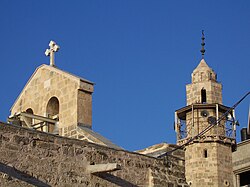Church of Saint Porphyrius
12th-century Eastern Orthodox church buildingsChurch buildings in the Kingdom of JerusalemChurches completed in 1150Churches in the Gaza StripEastern Orthodox church buildings in the State of Palestine ... and 5 more
Greek Orthodox churchesInstances of Lang-el using second unnamed parameterPages with Greek IPAWikipedia extended-confirmed-protected pagesZaytun Quarter

The Church of Saint Porphyrius (Greek: Εκκλησία του Αγίου Πορφυρίου, romanized: Ekklisía tou Agíou Porfyríou, IPA: [e.kliˈsi.a tu aˈʝi.u por.fiˈri.u]; Arabic: كَنِيسَة الْقِدِّيس بُرْفِيرْيُوس, romanized: Kanīsat al-Qiddīs Burfīryūs) is a Greek Orthodox church in Gaza City, State of Palestine. It belongs to the Patriarchate of Jerusalem and is the oldest active church in the city and is said to be the third oldest church in the world. Located in the Zaytun Quarter of the Old City of Gaza, it is named after the 5th-century bishop of Gaza, Saint Porphyrius, whose tomb is situated in the northeastern corner of the church.
Excerpt from the Wikipedia article Church of Saint Porphyrius (License: CC BY-SA 3.0, Authors, Images).Church of Saint Porphyrius
Alsheikh Mansoor, Gaza Gaza Old City
Geographical coordinates (GPS) Address Nearby Places Show on map
Geographical coordinates (GPS)
| Latitude | Longitude |
|---|---|
| N 31.5033062 ° | E 34.4620836 ° |
Address
Alsheikh Mansoor
Alsheikh Mansoor
888 Gaza, Gaza Old City
Palestinian Territories
Open on Google Maps




